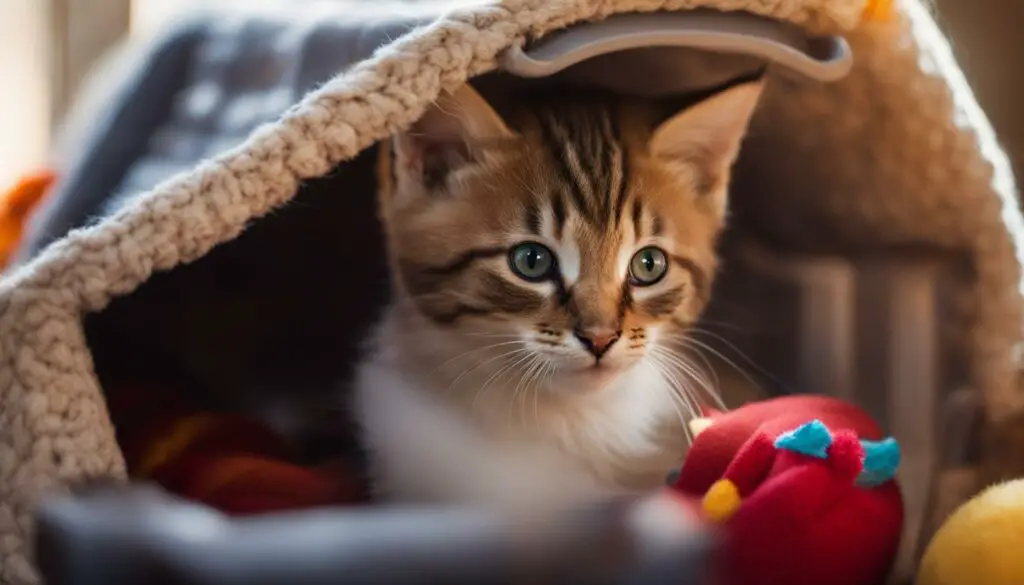Introducing a new kitten to your household can be an exciting but potentially challenging experience, especially when it comes to introducing a female kitten to a male cat. However, with the right approach and understanding of your pets’ behavior and social dynamics, you can increase the chances of a successful introduction and help your male cat accept a female kitten as part of the family.
Key Takeaways:
- Male cats can accept female kittens with the right approach and understanding of their behavior.
- Factors such as cat sociability, compatibility assessment, and creating a positive introduction environment play crucial roles in successful introductions.
- Slow and controlled introductions, addressing individual needs and territory concerns, as well as monitoring and managing interactions are essential steps in integrating a female kitten with a male cat.
- Seeking professional advice and support can help resolve conflicts and ensure a positive introduction.
- Patience, persistence, and providing individual attention and care are key to fostering a peaceful coexistence between a male cat and female kitten.
Factors that Influence a Cat’s Sociability Towards Other Cats
When introducing a new cat to your household, understanding their sociability towards other cats is essential for a successful integration. Cats, as individuals, have varying degrees of sociability, and factors such as gender, age, and previous experiences can influence their behavior towards other feline companions.
Male cats, for example, may exhibit different sociability towards female kittens compared to adult female cats. Similarly, female cats may respond differently to male kittens versus adult male cats. This gender dynamic can play a role in how cats interact and form relationships.
Other factors that can influence a cat’s sociability include their relationship with other cats in the household, their overall temperament, health, and past experiences with other cats. It’s important to consider these factors and tailor the introduction process accordingly to ensure a harmonious and stress-free integration.
| Factors | Influence on Sociability |
|---|---|
| Gender | Male cats may have different reactions to female kittens compared to adult female cats. The same applies to female cats and male kittens versus adult male cats. |
| Relationship with other cats in the household | If a cat has had positive experiences with other cats in the past, they may be more likely to be sociable and accepting towards a new cat. Conversely, negative experiences can lead to more hesitancy or aggression. |
| Age | Younger cats often have more adaptable and social behaviors, while older cats may be more set in their ways and less inclined to accept a new cat. |
| Health | Cats in poor health may be less inclined to socialize with a new cat, as they prioritize their own well-being and recovery. |
| Temperament | Each cat has a unique personality, and this can influence their sociability towards other cats. Some cats are naturally more friendly and accepting, while others may be more cautious or reserved. |
| Previous experiences with cats | Cats who have had positive experiences with other cats in the past are more likely to be sociable and accepting towards a new feline companion. Cats with negative experiences may exhibit more fear or aggression. |
Understanding these factors and tailoring the introduction process to your cats’ individual needs and behaviors can greatly increase the chances of a successful integration and a harmonious relationship between your new cat and existing feline companions.
Assessing Your Current Cat’s Compatibility with a New Kitten
Before bringing a new female kitten into your home, it is essential to evaluate your current male cat’s compatibility with the new addition. Assessing your cat’s temperament, sociability, health, age, and previous experiences with other cats can help you determine the likelihood of your male cat accepting a female kitten. Factors such as relatedness, neutering status, and overall well-being should also be considered in the compatibility assessment.
When assessing your cat’s temperament, observe how they interact with other animals and whether they display any aggressive or fearful behaviors. A calm and friendly cat is more likely to accept a new companion. Additionally, evaluating your cat’s sociability can provide insights into their willingness to share space and resources with another cat.
Consider your cat’s health and age as well. Older cats or those with underlying health issues may be less receptive to the presence of a lively and energetic kitten. Moreover, assess your cat’s previous experiences with other cats. Cats who have had positive interactions with other felines in the past are generally more open to accepting a new kitten.
Evaluating Cat Sociability
Assessing your cat’s sociability can involve observing their behavior during playtime, feeding, and interactions with other animals. Look for signs of aggression, territoriality, or excessive fear and anxiety. If your cat has a history of aggression towards other animals, it may indicate a lower compatibility with a new kitten. Consulting with a veterinarian or animal behaviorist can provide valuable insights and guidance in evaluating your cat’s sociability and compatibility with a new kitten.
| Factors to Consider | Potential Impact on Compatibility |
|---|---|
| Temperament | Calm and friendly temperament increases the likelihood of acceptance. |
| Sociability | Cats with a history of positive interactions are more likely to accept a new companion. |
| Health and Age | Older cats or those with underlying health issues may be less receptive to a new kitten. |
| Previous Experiences | Positive experiences with other cats increase the chances of acceptance. |
By carefully evaluating your current cat’s compatibility with a new kitten, you can make informed decisions and take appropriate steps to ensure a smooth and successful introduction process.
Creating a Positive Introduction Environment
When introducing a female kitten to a male cat, creating a positive introduction environment is crucial for a successful integration. One of the first steps is to provide a separate room for the new kitten. This allows both cats to become familiar with each other’s scent without direct interaction, reducing the chances of territorial aggression. The separate room should be equipped with all the necessary amenities, including food, water, litter box, toys, and a comfortable resting place for the kitten.
In addition to the separate room, gradual introduction is essential. This involves allowing the cats to see and smell each other in a controlled manner. Scent swapping can be done by rubbing a soft cloth on one cat and then placing it near the other cat’s sleeping area. This helps them become familiar with each other’s scent without face-to-face contact. Supervised interactions can also be introduced gradually, starting with short periods of time where the cats can see each other through a gate or cracked door.
Creating a safe space for the kitten is equally important. This means providing vertical spaces, such as cat trees or shelves, where the kitten can retreat to if needed. It’s also crucial to ensure that both cats have access to their own resources, such as food bowls, water bowls, and litter boxes. This reduces competition and minimizes the chances of conflict. By creating a positive introduction environment, you can foster a sense of security and comfort for both the male cat and female kitten.

| Benefits of a Positive Introduction Environment: |
|---|
| Reduces territorial aggression |
| Allows cats to become familiar with each other’s scent |
| Provides a safe space for the kitten to retreat to |
| Minimizes competition for resources |
| Creates a sense of security and comfort for both cats |
By following these steps and creating a positive introduction environment, you can increase the chances of a successful integration between your male cat and female kitten. Remember to take it slow, be patient, and monitor their interactions closely. If any signs of aggression or stress occur, it’s essential to consult with a veterinarian or animal behaviorist for further guidance and support.
Slow and Controlled Introductions
When introducing a female kitten to a male cat, it is important to proceed with slow and controlled introductions. This gradual approach allows both cats to acclimate to each other’s presence and build a positive relationship over time.
During the initial stages of the introduction, visual and auditory interactions can be beneficial. You can allow the cats to see and hear each other through a cracked door or baby gate. This allows them to become familiar with each other’s scent and vocalizations without direct contact.
As the cats become more comfortable, you can gradually increase their exposure to each other. This can be done by allowing supervised play sessions in a neutral area where both cats can explore and interact under your watchful eye. It is important to always prioritize the safety and well-being of both cats during these interactions.
| Slow and Controlled Introductions Checklist |
|---|
| Gradually expose the cats to each other’s presence |
| Allow visual and auditory interactions through a cracked door or baby gate |
| Supervise play sessions in a neutral area |
| Monitor the cats’ behavior and ensure their comfort and acceptance |
Slow and controlled introductions provide the cats with the opportunity to establish a positive association with each other. It gives them time to adjust and gradually build trust and acceptance. Remember to be patient and observe your cats’ body language and behavior during the process.
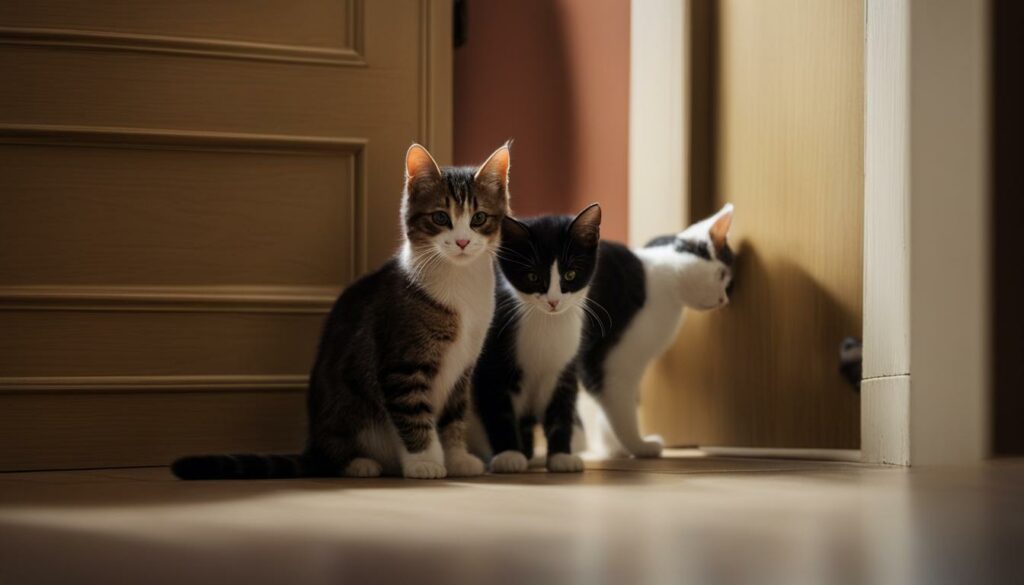
Addressing Individual Needs and Territory Concerns
When introducing a female kitten to a male cat, it is essential to address their individual needs and potential territorial behavior. Each cat has specific requirements and preferences that should be taken into consideration to foster a harmonious relationship. By providing separate resources, ensuring equal access to these resources, and minimizing competition, you can create a supportive environment for both cats.
Addressing territorial behavior is crucial during the introduction process. Cats are naturally territorial animals, and the introduction of a new kitten can disrupt their established territory. To alleviate potential conflicts, it is important to provide separate resting places, litter boxes, and feeding areas for each cat. This allows them to have their own personal space and reduces the chances of territorial disputes.
Ensuring equal access to resources is another key aspect of addressing individual needs and territory concerns. Each cat should have access to the same amenities, such as toys, scratching posts, and perches, to prevent one cat from feeling deprived or threatened. Providing these resources in different areas of the house can help distribute them evenly and reduce potential competition.
| Resources | Male Cat | Female Kitten |
|---|---|---|
| Resting Places | Cozy bed in the living room | Soft blanket in the bedroom |
| Litter Boxes | One in the laundry room | One in the bathroom |
| Feeding Areas | Food bowl in the kitchen | Food bowl in the dining room |
| Toys | Interactive toys in the playroom | Balls and mice in the hallway |
By addressing individual needs and territorial behavior, you can create an environment that promotes harmony and reduces potential conflicts between your male cat and female kitten. Remember to observe their behavior, adjust resources as needed, and provide positive reinforcement to encourage their acceptance of each other. With time and patience, the male cat and female kitten can establish a peaceful coexistence and develop a strong bond.
Image source: cat resources
Monitoring and Managing Interactions
When introducing a female kitten to a male cat, it is essential to closely monitor and actively manage their interactions to ensure a smooth integration. By promoting positive interactions, redirecting aggression, and prioritizing the safety of both cats, you can foster a harmonious relationship between them.
One of the key aspects of monitoring interactions is to observe the body language and behavior of both the male cat and female kitten. Look for signs of stress, fear, or aggression, and intervene if necessary. Redirecting aggression can be done by using a distraction, such as a toy or a treat, to divert their attention from any potentially negative interactions. This helps to promote positive associations and prevent conflicts.
Additionally, ensuring safety is crucial during the introduction process. This can be achieved by providing separate spaces for each cat, especially in the initial stages, to reduce the chances of territorial disputes. Gradually increasing their access to shared spaces under supervision allows for controlled interactions and helps them become accustomed to each other’s presence.
Promoting Positive Interactions
Encouraging positive interactions between the male cat and female kitten is paramount for a successful integration. Play sessions with interactive toys can help them bond and build a positive association with each other. Providing separate resources such as food bowls, water bowls, and litter boxes can alleviate competition and reduce the risk of conflicts.
“By promoting positive interactions, redirecting aggression, and prioritizing the safety of both cats, you can foster a harmonious relationship between them.”
It’s important to note that the pace of integration may vary between cats. Some may take longer to establish a bond and feel comfortable around each other. Patience and consistent positive reinforcement are key during this process. Remember to reward both the male cat and female kitten for their calm and friendly behavior to encourage further positive interactions.
By monitoring their interactions, managing their behavior, promoting positive associations, and ensuring their safety, you can increase the likelihood of a successful integration between your male cat and female kitten. With time and patience, they can develop a harmonious relationship and enrich each other’s lives as part of your feline family.
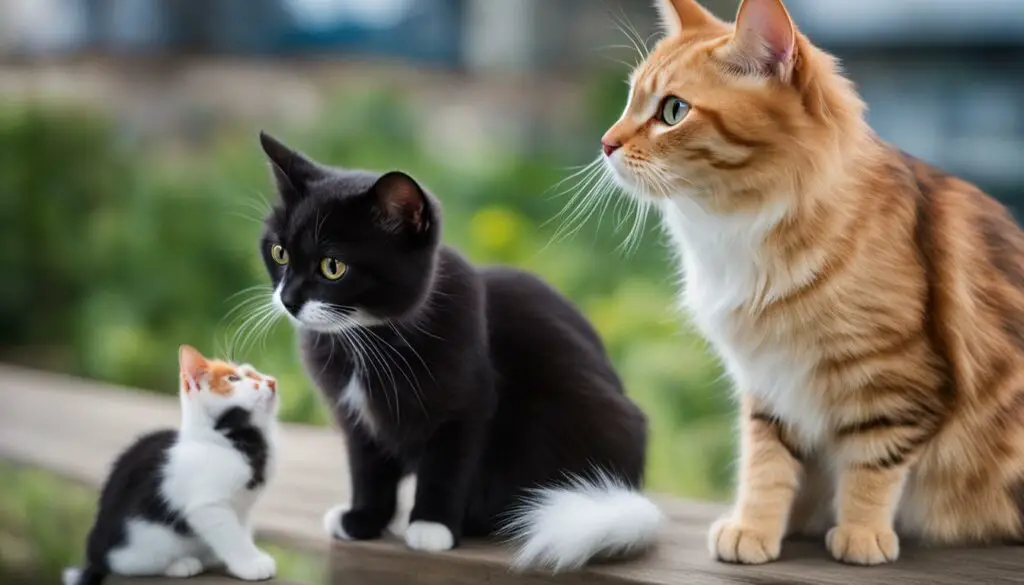
Seeking Professional Advice and Support
Introducing a new kitten to your male cat can sometimes require expert guidance and support. If you encounter difficulties or conflicts during the introduction process, it is important to seek professional advice from a veterinarian or animal behaviorist. These professionals have the knowledge and experience to assess your specific situation and provide tailored advice to ensure a successful integration of your male cat and female kitten.
Consulting with a veterinarian or animal behaviorist can help in resolving cat conflicts and addressing any challenges that may arise during the introduction process. They can provide valuable insights on understanding your male cat’s behavior and body language, as well as offer techniques to promote positive interactions between your male cat and female kitten.
Professional guidance is especially important if your male cat’s aggression towards the female kitten persists or escalates. It is crucial to address any issues early on to prevent potential harm to either cat and to foster a safe and harmonious environment for both.
Remember, seeking professional advice and support is a proactive step to ensure the well-being and happiness of your male cat and female kitten, and to promote a successful integration that will lay the foundation for a lifelong bond between them.
| When to Seek Professional Advice and Support | Benefits of Consulting with a Veterinarian or Animal Behaviorist |
|---|---|
| The introduction process is met with aggression or hostility from the male cat | Expert assessment and guidance tailored to your specific situation |
| Conflict between the male cat and female kitten persists or escalates | Understanding your male cat’s behavior and body language |
| Concerns about the safety and well-being of both cats | Techniques to promote positive interactions and reduce aggression |
| Need for additional strategies to foster a harmonious environment | Prevention of potential harm to either cat |
Patience and Persistence
Introducing a female kitten to a male cat requires patience and persistence. Each cat has their own unique personality and timeline for acceptance, so it’s important to allow the bonding process to unfold gradually. Rushing the introduction can lead to stress and conflict between the cats, so take your time and be patient.
It’s normal for the male cat to initially show signs of hesitation or even aggression towards the new kitten. This is a natural instinct as cats are territorial animals. Give them space and time to adjust to each other’s presence through gradual and supervised interactions.
Remember, the bonding process takes time. It can range from a few days to several weeks or even months. Be persistent in providing positive experiences for both cats, such as interactive play sessions and feeding them in separate but adjacent areas. This helps establish positive associations and reduces tension between the cats.
| Key Points | Actions |
|---|---|
| Be patient | Allow the cats to adjust at their own pace |
| Supervise interactions | Ensure the safety of both cats and redirect any aggression |
| Provide positive experiences | Engage in play sessions and feed the cats in separate but adjacent areas |
The gradual bonding process between a male cat and a female kitten requires patience and persistence. By allowing the cats to adjust at their own pace, supervising their interactions, and providing positive experiences, you can increase the chances of a successful integration and a harmonious relationship.
Providing Individual Attention and Care
When introducing a new kitten to your household, it’s important to remember that each cat has unique needs and requires individual attention and care. Bonding with each cat and spending quality time with them is crucial for building a strong and trusting relationship.
By dedicating time to each cat, you can meet their individual needs and ensure they feel loved and valued. This can involve activities such as grooming, interactive play sessions, and providing a comfortable and secure environment for them to thrive in.
Additionally, it’s important to create moments for one-on-one interaction with each cat, away from distractions. This can help strengthen your bond and allow you to better understand their personalities and preferences. Remember, building a positive relationship with your male cat and female kitten takes time and patience, but the rewards are well worth it.
| Benefits of Individual Attention for Cats |
|---|
| 1. Enhances bonding and trust between you and each cat. |
| 2. Provides an opportunity to address each cat’s specific needs and preferences. |
| 3. Helps prevent feelings of neglect and jealousy between the cats. |
| 4. Allows you to observe any changes in behavior or health on an individual basis. |
Meeting Individual Needs
Meeting the individual needs of your male cat and female kitten is essential for their overall well-being and happiness. This includes ensuring they have access to their own food and water bowls, litter boxes, and resting areas. By providing separate resources, you can minimize competition and potential conflicts between the cats.
It’s also important to pay attention to each cat’s dietary requirements and provide them with a balanced and appropriate diet. Consulting with your veterinarian can help you determine the best nutritional plan for each cat, taking into consideration their age, health, and any specific dietary needs they may have.
Remember, every cat is unique, and what works for one cat may not work for another. By providing individual attention and meeting the specific needs of your male cat and female kitten, you can create a harmonious environment where both cats can thrive and coexist peacefully.
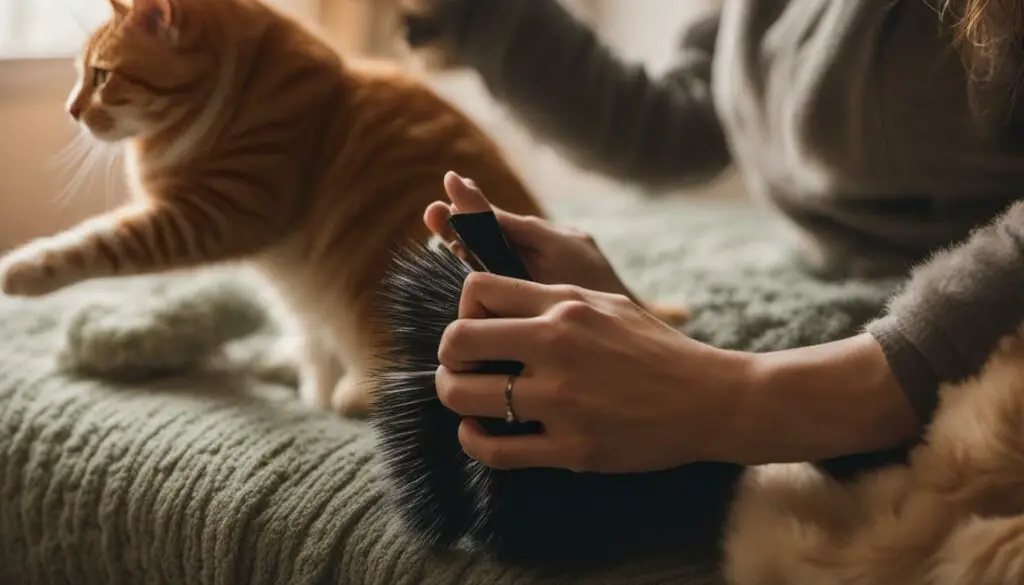
Gradual Integration and Increased Socialization
Once the initial introductions and scent swapping have taken place, it’s time to move on to the next phase of integrating your male cat and female kitten – gradual integration and increased socialization. This step-by-step process allows the cats to become more familiar with each other’s presence and gradually build a positive relationship.
To facilitate gradual integration, provide supervised interactions between the male cat and female kitten in shared spaces. This can include playtime, feeding, or simply allowing them to coexist in the same room while you monitor their behavior. By supervising their interactions, you can intervene if any signs of aggression or stress arise, ensuring the safety of both cats.
Additionally, gradually increasing the female kitten’s access to shared spaces in your home can help the cats acclimate to living together. Start by providing access to one room at a time, and once they have adjusted well, gradually expand their access to other areas. This controlled exposure allows them to explore and establish their own territories, reducing the likelihood of territorial disputes.
Remember, patience is key during this process. Each cat will have their own unique pace in accepting a new companion, so it’s crucial to respect their boundaries and allow them to adjust at their own speed. By providing opportunities for gradual integration and increased socialization, you can foster a positive and harmonious relationship between your male cat and female kitten.
The Benefits of Gradual Integration
A gradual integration approach offers several benefits for the successful coexistence of your male cat and female kitten:
- Reduces stress and anxiety: By gradually introducing the cats and providing supervised interactions, you minimize the stress and anxiety they may experience during the integration process.
- Promotes positive associations: Gradual integration allows the cats to associate each other’s presence with positive experiences, such as playtime and mealtime, fostering a positive relationship.
- Prevents conflicts: By slowly increasing the female kitten’s access to shared spaces and respecting the cats’ boundaries, you minimize the chances of territorial conflicts and aggression.
- Allows for adjustment periods: Each cat requires time to adapt to a new dynamic, and a gradual integration approach provides them with the necessary adjustment period.
By implementing a gradual integration process along with increased socialization opportunities, you can set the foundation for a harmonious and lasting relationship between your male cat and female kitten.
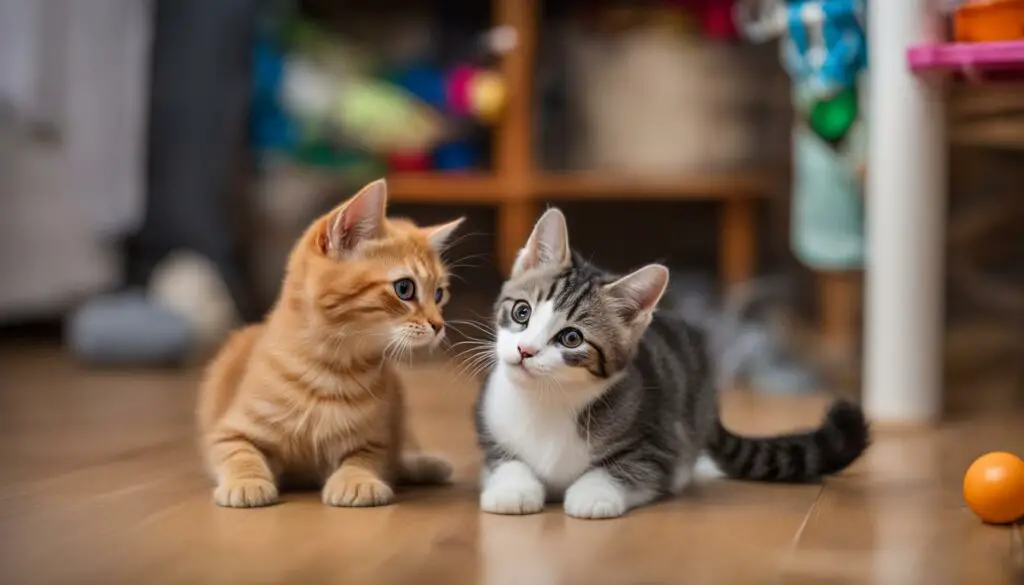
| Benefits of Gradual Integration |
|---|
| Reduces stress and anxiety |
| Promotes positive associations |
| Prevents conflicts |
| Allows for adjustment periods |
Maintaining a Peaceful Coexistence
Once the male cat and female kitten have successfully integrated into a coexistence, ongoing management and care are essential to ensure a harmonious and peaceful environment for both cats. This involves addressing their individual needs, maintaining a consistent routine, and providing a stimulating environment that promotes their overall well-being.
Individual Needs
Each cat has unique needs that must be met to maintain a peaceful coexistence. This includes providing separate resources such as food bowls, litter boxes, and resting places to prevent competition and reduce potential conflicts. Additionally, spending quality time with each cat individually, engaging in play sessions and offering affection, helps strengthen the bond between you and each of your furry companions. Meeting their individual needs allows them to feel loved and valued, contributing to a positive relationship between the male cat and female kitten.
Ongoing Management
Maintaining a peaceful coexistence requires ongoing management and attention to the cats’ behavior and interactions. Regular veterinary check-ups are important to ensure their health and well-being. Monitoring their behavior and addressing any signs of stress, aggression, or territorial behaviors promptly can help prevent conflicts from escalating. Providing appropriate toys and enriching their environment with scratching posts, climbing trees, and interactive toys can also help redirect their energy and stimulate their natural instincts. By proactively managing their needs and behaviors, you can promote a harmonious coexistence between your male cat and female kitten.
Consistent Routine
Establishing and maintaining a consistent routine is crucial for both cats to feel secure and comfortable in their environment. This includes regular feeding times, play sessions, and designated rest periods. Consistency in the daily routine helps reduce stress and provides a sense of predictability for the cats. It is also important to continue following the introduction guidelines initially implemented to ensure a smooth transition into a coexistence. By maintaining a consistent routine, you can contribute to a peaceful and stable environment for your male cat and female kitten.
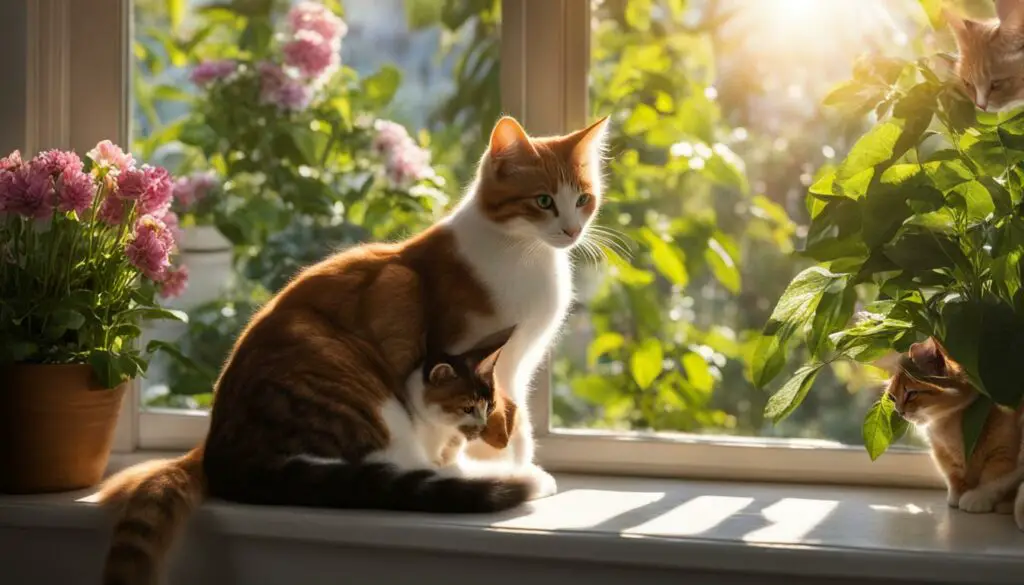
Stimulating Environment
A stimulating environment is essential to prevent boredom and encourage positive interactions between the male cat and female kitten. Providing opportunities for mental and physical stimulation, such as interactive toys, puzzle feeders, and playtime with interactive laser toys or feather wands, can help keep both cats engaged and entertained. Creating vertical spaces with cat trees or shelves allows them to explore and establish their territory in a three-dimensional environment. Ensuring a variety of safe hiding spots and cozy resting places also gives them the freedom to relax and recharge. A stimulating environment not only enhances their overall well-being but also fosters a peaceful coexistence between your male cat and female kitten.
By attending to their individual needs, implementing ongoing management strategies, maintaining a consistent routine, and providing a stimulating environment, you can promote a peaceful coexistence between your male cat and female kitten. Remember, a harmonious relationship takes time and effort, but with patience and care, they can thrive together as members of your family.
Conclusion
In conclusion, introducing a female kitten to a male cat can be a successful and rewarding experience when approached with care and understanding. By following these tips for introducing a female kitten to a male cat, you can increase the chances of a harmonious integration and acceptance between the two feline companions.
Remember to assess your current cat’s compatibility with the new kitten, create a positive introduction environment, and ensure slow and controlled introductions. Monitoring and managing their interactions, addressing individual needs and territory concerns, and seeking professional advice when needed are also crucial steps in fostering a peaceful coexistence.
With patience, persistence, and providing individual attention and care to both your male cat and female kitten, you can facilitate their bonding process and promote a harmonious relationship. By gradually integrating them and increasing their socialization opportunities, you can ensure their ongoing well-being and peaceful coexistence.
Overall, successful integration of a male cat and female kitten requires understanding, patience, and a gradual approach. By implementing these tips and guidelines, you can help your pets form a strong and lasting bond, creating a loving and happy home for all.
FAQ
Will my male cat accept a female kitten?
Introducing a new female kitten to your male cat can be a challenge, but with the right approach and understanding of their behavior, there is a chance of acceptance.
What factors influence a cat’s sociability towards other cats?
Factors such as gender, relationship to other cats in the household, age, health, temperament, and previous experiences can influence a cat’s sociability with other cats.
How can I assess my current male cat’s compatibility with a new kitten?
You can assess compatibility by considering your cat’s temperament, sociability, health, age, previous experiences, relatedness, neutering status, and overall well-being.
How can I create a positive introduction environment?
Providing a separate room for the new kitten initially allows both cats to become familiar with each other’s scent without direct interaction. Gradual introductions, scent swapping, and supervised interactions help establish a safe and low-stress environment.
How should I approach slow and controlled introductions?
Gradual exposure to each other’s presence, visual and auditory interactions, and supervised play sessions can help the male cat and female kitten acclimate to each other. Monitor their interactions and adjust the pace based on their comfort levels.
How can I address individual needs and territory concerns?
Provide separate resources such as resting places, litter boxes, and feeding areas. Ensuring equal access to resources helps minimize competition and reduce potential conflicts.
How can I monitor and manage interactions between my cats?
Promote positive interactions, redirect aggression, and ensure the safety of both cats. Use positive reinforcement and address signs of stress or aggression.
What should I do if I encounter difficulties during the introduction process?
Seeking professional advice and support from a veterinarian or animal behaviorist can help resolve conflicts and provide tailored advice for a successful introduction.
How important is patience and persistence in the integration process?
Patience is key as the integration process takes time. Each cat has their own pace in accepting a new companion, so be persistent and allow for a gradual bonding process.
Should I provide individual attention and care to each cat?
Yes, bonding with each cat through quality time, meeting their individual needs, and making them feel loved and valued can strengthen their bond and promote a positive relationship.
How can I gradually integrate and increase socialization between my cats?
Allow supervised interactions in shared spaces and gradually expand their access to the entire home. Monitor their behavior and adjust the pace based on their comfort levels.
How can I maintain a peaceful coexistence between my male cat and female kitten?
Ongoing management, care, and attention to their individual needs will contribute to their continued well-being and positive relationship. Regular veterinary check-ups, a consistent routine, and a stimulating environment can help foster a peaceful coexistence.
How can I ensure a successful integration of a female kitten with my male cat?
By following the tips and guidelines provided in this guide, you can increase the chances of a successful integration and a harmonious relationship between your male cat and female kitten.

